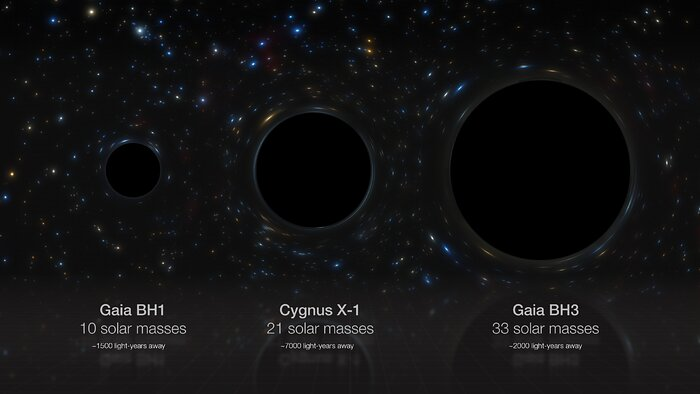The newly discovered black hole has a mass 33 times that of the sun. This easily surpasses the previous record for a stellar black hole in our galaxy (about 20 solar masses) and helps confirm theories about how objects of this mass formed.
The largest stars end their lives as supernovae, catastrophic explosions that create black holes. These black holes are much less massive than the stars they come from because a lot is thrown away during their lifetimes and supernova events.
There is no doubt that many such black holes lurk in our galaxy, and we have little chance of discovering them. Fortunately, most exploding stars are part of binary star systems when they exist, and sometimes even larger star clusters. Some companions are thrown off by the supernova’s force and wander alone in the Milky Way, but those that are more massive or more distant survive and orbit the black hole, reminding us of its presence.
When stars are observed to wobble periodically, it means that the gravity of some other object is affecting them. Sometimes, it could be a dimmer star that we can’t see, or even a planet, but in the case of a new discovery, that’s unlikely. The object causing the star 2MASS J19391872+1455542 to orbit in 11.6 years has a mass thousands of times that of the largest planets. If it were a star, it would be so bright that we could probably see it with the naked eye.
Such an invisible mass must be a black hole about 50% larger than Cygnus X-1, the remnant of the largest such explosion previously known in our galaxy.
The comparison between Gaia BH3 and the largest stellar black hole we have ever discovered is also a typical example. The mass of a black hole is proportional to its radius, not its volume.
Image source: ESO/M.Cohen Messer
The discovery was made by combing through data from the Gaia telescope, which tracks the motion of stars with astonishing precision. This is the third time such a search has yielded such a discovery, so the object has been dubbed Gaia BH3. In addition to its massive mass, Gaia BH3 is 2,000 light-years away in the constellation Aquila, not exactly at the end of the street, but if the Milky Way were a big city, this would be the next suburb.
Pasquale Panuzzo of the Paris Observatory said in a statement that no one expected to find a so-far undiscovered massive black hole nearby. “This is a once-in-a-lifetime discovery.”
The Gaia observations themselves may have had other causes, but a large international team used the European Southern Observatory’s Very Large Telescope (VLT) to confirm the measurements and reveal more.
We might expect that if such objects could be ignored in our own galaxy, then we would be in the dark about their presence elsewhere. Surprisingly, this is wrong. Gravitational waves alert us to the existence of larger stellar black holes billions of light-years away. However, since this only works when two objects whose mutual orbits have decayed collide, this rarely happens, and we know of only a few cases, all at very large distances.
Astronomers’ hypothesis for such massive black holes is that they come from very metal-poor stars: black holes are formed almost entirely from hydrogen and helium produced in the Big Bang. These stars are likely to be much more massive than stars in the modern universe. It is also thought that they lose less mass through stellar winds, thus retaining mass until the formation of the black hole.
It’s a plausible idea, but we can’t prove it using black holes detected by gravitational waves. The Gaia BH3 changes that. Stars in binary systems usually have similar compositions, except in rare cases where they were not formed together or, more commonly, one star swallowed a planet large enough to significantly increase its metal content.
Dr. Elisabetta Caffau and co-authors used the VLT Ultraviolet and Visible Echelle Spectrometer to confirm that J19391872+1455542 is indeed very metal-poor, making it likely that the star it is Gaia BH3 will be as well. J19391872+1455542 is a very old star, as we would expect with such a low metal content, and has already begun the process of becoming a red giant despite being three-quarters the mass of the Sun.
A full analysis of Gaia’s BH3 won’t be completed until at least late 2025, but the team responsible for the discovery hopes to give other astronomers a chance to observe it for themselves, maximizing their chances of learning more.
The findings are published in the journal Astronomy and Astrophysics and are available for open access.
#Milky #Ways #recordbreaking #stellar #black #hole #mass #equivalent #suns
Image Source : www.iflscience.com
